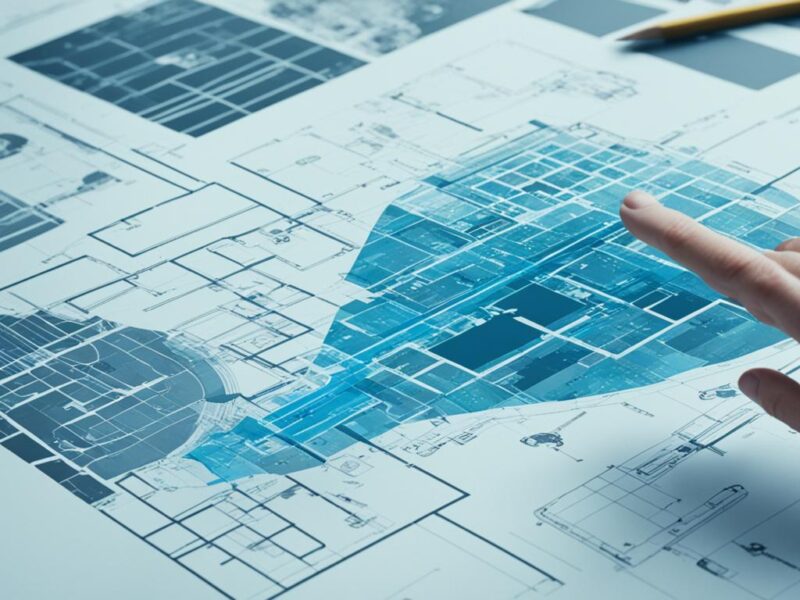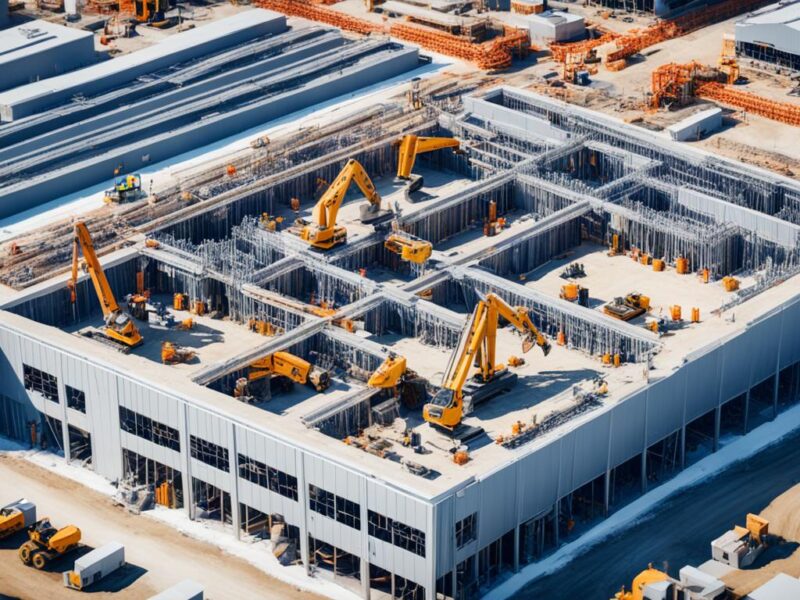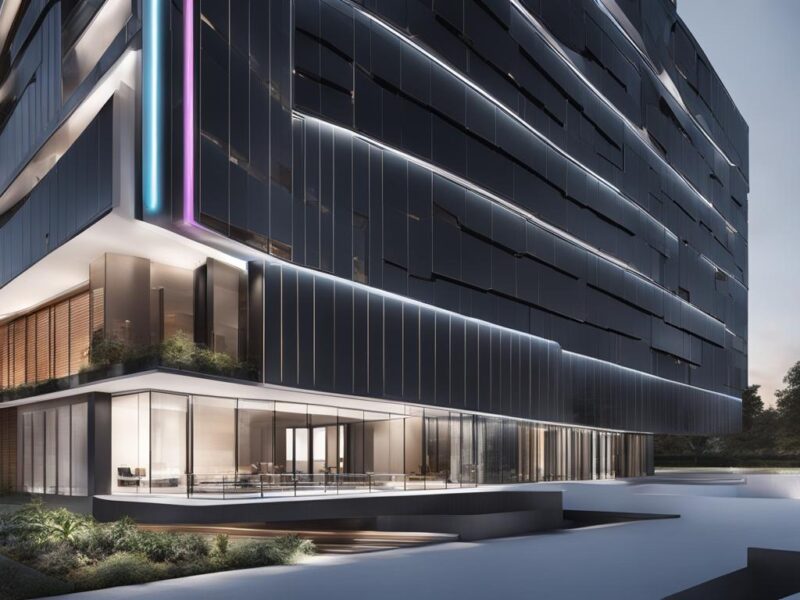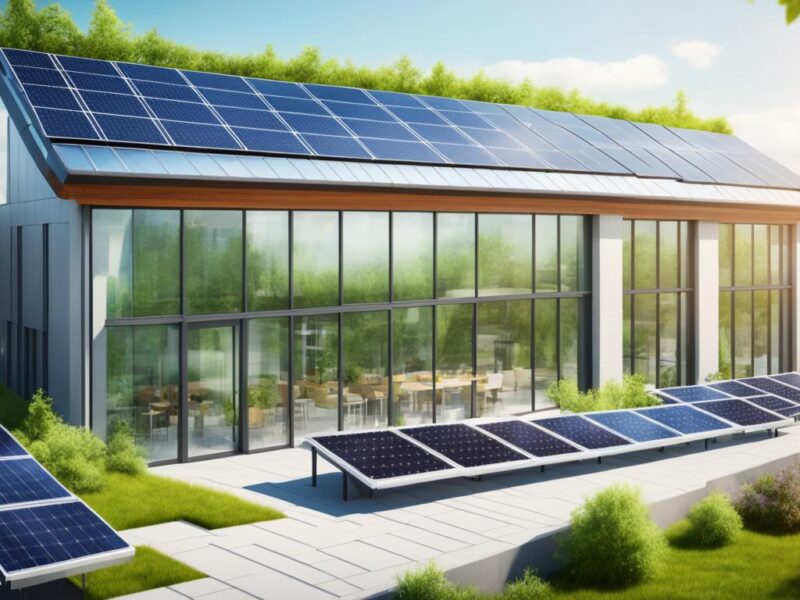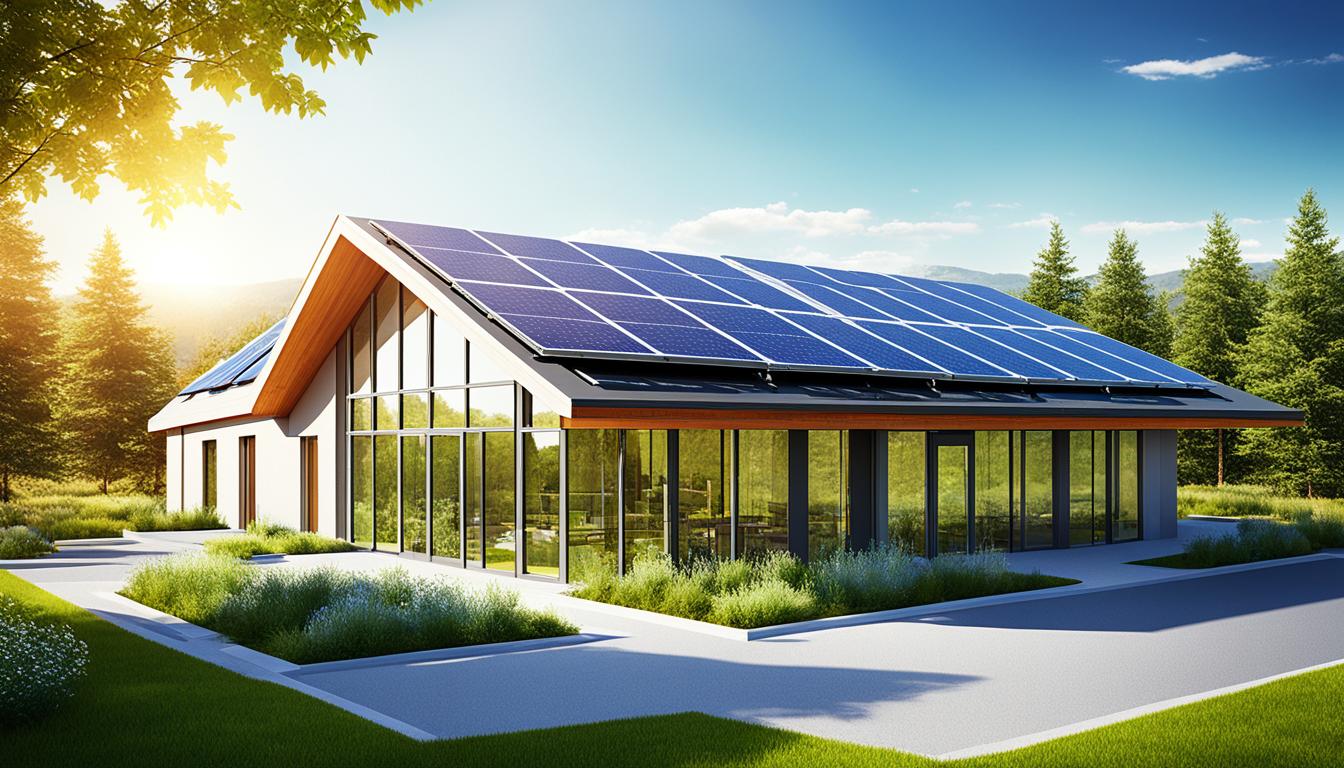
Zero-Energy Buildings: Practical Goal or Unrealistic Standard?
Did you know buildings use up 39% of total energy consumption in the United States? This big number shows we need to focus on building more energy-efficient places. The idea of zero-energy buildings (ZEBs) is becoming popular. It’s seen as a way to lessen our impact on the environment and push for greener designs.
Zero-energy buildings aren’t just about saving energy. They aim to create as much energy as they use. This results in a net-zero energy balance. With renewable energy systems, eco-friendly technology, and green materials, ZEBs are key for a greener future.
The idea of zero-energy buildings may sound hard to reach. Yet, it’s becoming more possible. This piece will explain what ZEBs are, how they’re designed, and their perks. It will also cover how they connect to the grid and related policy discussions. Lastly, we’ll look into how realistic it is to build them.
Key Takeaways:
- Zero-energy buildings aim to produce as much energy as they consume, achieving a net-zero energy balance.
- Integration of renewable energy systems, green building technology, and sustainable building materials is crucial in achieving zero-energy building goals.
- Zero-energy buildings contribute to a more sustainable future by reducing carbon emissions and minimizing energy consumption.
- Policy initiatives and decreasing costs of renewable energy are making zero-energy buildings more financially realistic.
- The feasibility of zero-energy buildings has increased due to more stringent building codes and the adoption of energy-efficient systems and strategies.
What Makes a Building Zero Energy?
To create a zero-energy building, you need to focus on several key factors. These elements are critical for achieving energy independence. They help in founding zero-energy buildings on a strong basis.
1. Sound Structure
First, you need a strong and durable foundation. This makes sure the building lasts long and can face different weather conditions.
2. Fireproof Measures
Fire safety is very important. By using fire-resistant materials and setting up sprinkler systems, the safety of people and the building improves.
3. Effective Insulation
Preventing energy loss needs effective insulation. Good quality insulation, like spray foam, creates a barrier. It stops heat from escaping through walls and roofs.
4. HVAC System Design
The HVAC system design is also crucial. A well-designed system uses less energy. It helps in keeping buildings efficient and reduces energy use.
5. Window Applications
Windows play a big role in zero-energy buildings. By choosing the right type, like tilt-and-turn windows, natural light is used more efficiently. This cuts down on the need for artificial lighting.
6. LED Lighting
It’s important to use electricity wisely. LED lighting is energy-efficient and bright. It also lasts longer, which means saving on repair costs.
7. Heat Pump
Choosing a heat pump for heating and cooling is more energy-efficient. Heat pumps use renewable sources, like geothermal heat, to work. This lessens the dependence on nonrenewable energy sources.
Keeping these factors in mind during design and construction can lead to zero-energy buildings. Such buildings are sustainable and support a greener future.
Connection to the Grid Infrastructure
Zero-energy buildings may need traditional energy from utilities when their own production is low. These buildings then use extra electricity from the grid. Yet, they can give surplus energy back to the grid. This helps balance their energy use over time.
These buildings can adjust when energy prices change. This makes them fit well with current energy systems. They use less primary energy, making them more efficient.
Zero-energy buildings use special strategies to work well with the grid. They have their own energy systems and storage. This helps both the building and the grid. Energy is shared between them as needed.
Definition and Concepts of Zero-Energy Buildings
Zero-energy buildings (ZEBs) stand out for their high energy efficiency and low global energy use. These green buildings aim to decrease energy needs and use renewable energy to reach zero energy usage. The renewable energy comes from either on-site or nearby sources, making them self-sufficient and eco-friendly.
ZEBs use smart design and advanced technology to boost energy efficiency. Their energy use is almost none each year. This is because they focus on saving energy, using efficient systems, and relying on renewable energy sources.
ZEBs aim to create as much energy as they use. They do this by tapping into renewable sources like solar, wind, and geothermal energy. By using these clean resources, ZEBs cut down on nonrenewable energy use and help create a more sustainable world.
Zero-energy buildings are at the forefront of sustainable architecture. They blend modern design with renewable energy to meet human needs while protecting the environment.
ZEBs are not just for homes; they work for commercial buildings, schools, hospitals, and more. Using zero-energy designs in various buildings encourages wider use of energy-saving practices. This helps greatly reduce greenhouse gas emissions.
Besides aiming for zero energy usage, ZEBs can produce more energy than they need, known as net positive-energy buildings. Meanwhile, nearly zero-energy buildings generate a lot of their own energy but don’t fully cut out nonrenewable energy use.
To show what makes zero-energy buildings special, here’s a table comparing them to conventional buildings:
| Criteria | Zero-Energy Buildings | Conventional Buildings |
|---|---|---|
| Energy Performance | Very high with low global energy consumption | Higher energy consumption, reliance on nonrenewable energy |
| Energy Sources | Rely on renewable energy sources | Reliance on nonrenewable energy sources |
| Carbon Footprint | Significantly reduced carbon emissions | Higher carbon emissions |
| Environmental Impact | Minimize ecological footprint, promote sustainability | Higher environmental impact |
The table shows the many benefits and potential of zero-energy buildings. Through cutting-edge efficient technologies, green design strategies, and renewable energy, ZEBs lead us toward a future focused on saving our planet and being energy independent.
Advantages of Zero-Energy Buildings
The benefits of zero-energy buildings go further than just lower energy use and carbon footprint reduction. They include:
- Lower energy bills for occupants
- Better indoor comfort and air quality
- Less reliance on fossil fuels
- Greater resilience and energy self-reliance
- Support for environmental sustainability and fighting climate change
As our world looks to sustainable development and fighting climate change, zero-energy buildings stand out as a key solution. They positively impact energy saving, environmental protection, and quality of life, offering hope for a greener, more sustainable future.
Zero Energy Building Definitions and Policy Activity
Governments worldwide have rolled out ZEB policies and initiatives. Their aim is to boost energy performance in buildings. They also want to encourage the use of renewable energy. The ultimate goal is for zero-energy buildings to be the norm.
The cost of solar panels is going down. There are new ways to finance green projects. And, there are new methods to design and assess buildings. All these factors are making it easier to afford net-zero energy buildings.
Now, the goal is not just zero-energy but also zero-carbon buildings. In the future, we aim for buildings that produce more energy than they use.
To get to zero-energy buildings, governments have put in place new policies. These policies promote energy-saving and use of renewables in new and old buildings.
Key Components of ZEB Policies
- Mandatory energy efficiency standards for new construction and retrofit projects
- Incentives and grants for installing renewable energy systems
- Building codes that push for saving energy and using renewables
- Green financing options to make zero-energy steps easier to take
- Rules for keeping track of and sharing energy performance
“Zero-energy buildings are no longer just a special case; they’re becoming key in sustainable construction worldwide.”
These policies are making the building industry greener. They also help fight climate change and cut greenhouse gas emissions.
The construction sector is crucial for sustainable development. It’s about more than just saving energy. It also involves carbon neutrality and building resilient structures.
By pushing ZEB policies and zero-energy building development, governments promote greener cities. This also lessens the environmental harm caused by buildings.
Adopting net-zero energy is good for the planet and for people’s wallets. Zero-energy buildings usually cost less to run. They’re worth more and are better places to live or work in.
With tech getting better and cheaper, zero-energy buildings will become a popular choice. They are great for homes and business sites alike.
Net-Zero Energy Buildings: Feasibility and Benefits
Net-zero energy buildings are becoming more feasible these days. Lower costs for solar panels, smart design, and better technology make this goal more reachable. They use little energy and save you money in the long run.
These buildings use smart design to reduce energy needs. They have great insulation, special windows, and are built to use natural light and air. This way, they need less heating, cooling, and electric lights. Then, energy-efficient systems, like smart HVAC, help use even less energy.
Solar technology plays a big role in making buildings energy-free. With solar panels, buildings can make their own clean electricity. The cost of solar tech is going down, thanks to government help, making it easier to use.
“Net-zero energy buildings represent a new way of thinking about buildings. They use renewable energy and efficient systems, cutting down our impact on the planet while saving money.”
For net-zero buildings to spread, they need to make financial sense. Looking at costs over time shows they’re a good deal. Even if they’re expensive to set up, the money saved on energy and upkeep will cover those costs.
Keeping a net-zero building running well is key. Regular checks help find and fix problems. This means everyone in the building needs to work together to save energy and keep things running smoothly.
Benefits of Net-Zero Energy Buildings
These buildings bring a lot of good things:
- They lower your energy bills and save money over time.
- They cut down on fossil fuel use and pollution.
- They make indoor spaces nicer and healthier to live and work in.
- They show we care about the planet and help us lead the way in green building.
- They might get you special government deals for being energy-wise.
As we all focus more on saving energy and protecting the environment, net-zero buildings lead the way. They’re a smart choice for anyone looking to invest in the future of our planet and save money too.
Designing for Net-Zero Energy
Creating a net-zero energy building means looking at the whole picture from the start. This includes bringing engineers in early and thinking about how the building will work in the future. Doing this ensures the building is both efficient and sustainable.
Having engineers on board from day one is crucial. They work with architects to make sure all parts of the building work well together. This teamwork leads to a building that uses energy wisely, aiming for net-zero.
Checking how well the building performs after people start using it is also key. This check-up makes sure the building lives up to its design goals. If any problems pop up, they can be fixed to keep energy use low.
How people act inside the building affects its energy use too. Teaching occupants to save energy can make a big difference. Simple actions like turning off lights save a lot of energy over time.
Parametric Analysis for Optimal Performance
Parametric analysis helps find the best design options for saving energy. It uses computer models to see how changes in design affect energy use. Things like where windows go or how much insulation to use are tested.
With this analysis, designers can pick the best ways to save energy. It helps them make smart choices. This balances saving energy, being comfortable, and keeping costs down.
Thinking about how the building will run in the long term is important too. It means choosing materials that last and don’t need much upkeep. Regular checks on the building’s energy use also keep it running efficiently.
Net-zero energy design takes a well-rounded approach. It includes teamwork from the start, checks on how well the building works, teaching people to save energy, and planning for the future. Following these steps helps create buildings that use energy wisely and are better for our planet.
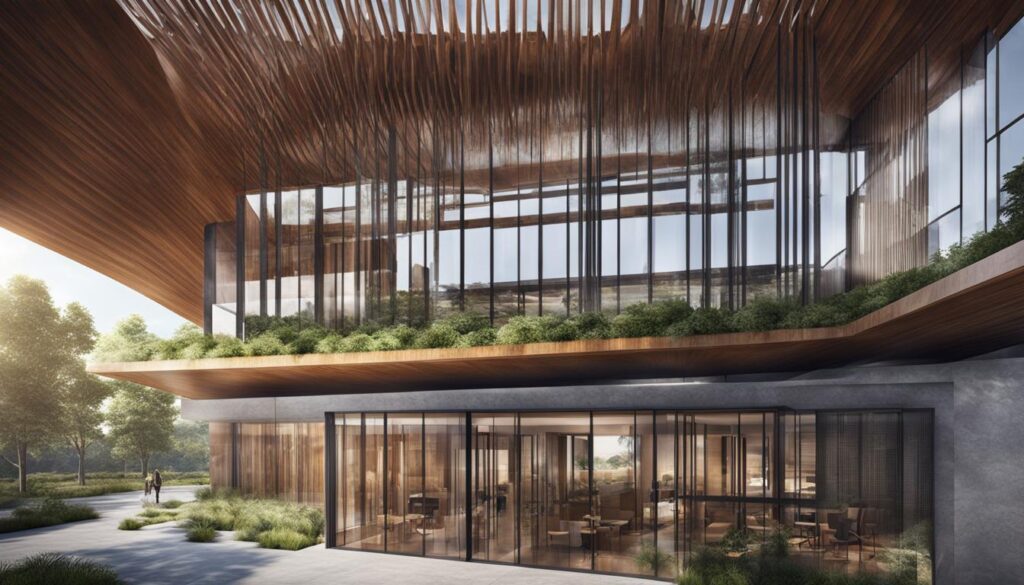
Conclusion
Zero-energy buildings are now a real choice for many types and sizes. They use smart energy strategies and renewable systems. This way, they reach net-zero energy goals. They reduce energy use and cut down carbon emissions. This helps our planet.
Renewable energy costs are dropping, and building rules are getting tougher. This means more people will start using net-zero energy methods. The push for green development is making zero-energy buildings more popular.
Choosing zero-energy practices is good for Earth and saves money over time. It lowers energy use and depends on renewable sources. This can cut costs and even make money by selling extra energy. These buildings also offer healthier places for people to stay.




